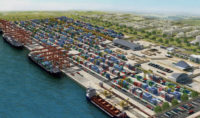Despite concerns raised by International Rivers and other environmental groups, Nigeria has awarded Chinese contractor China Civil Engineering Construction a $5.8-billion contract to construct a large hydroelectric power plant at the Donga River in Tafara State.
The 3,050-MW hydropower plant project has been on and off for more than 35 years, as previous contracts fell through due to claims of high-level corruption and lack of political goodwill from top government leaders.
This is the second major hydroelectric power project awarded to a Chinese firm: A consortium of China National Electric Engineering Co. and Sinohydro Group won the $1.2-billion contract for the Zungeru power project in Nigeria's Niger State. That project now is slated for commercial operation by the end of 2019, two years beyond the original deadline. The 700-MW Zungeru project on Kaduna River commenced in 2013 for a 48-month period but has faced opposition from local communities. Other reasons given for the delay include several incidents of armed robberies and kidnapping of construction workers.
In August, Nigeria's Power, Works and Housing Minister Babatunde Fashiola said China's Export-Import Bank has agreed to provide 85% financing for the Mambilla power plant, located 600 kilometers from the capital Abuja, while the Nigerian government will provide the remaining 15%.
An initial design by French firm Coyne et Bellier, the hydropower division of Tractebel Engineering, indicated that the power project, initially 2,600 MW before it was increased to 3,050 MW, will take advantage of a drop in elevation of more than 1,000 meters, from the Mambilla plateau to the plain below, to maximize the full potential of the Donga River. The river marks the international Nigeria-Cameroon boundary and flows northwest to merge with Benue River, also in Nigeria.
Coyne said the power project's proposed Gembu Dam will be a rolled-compact-concrete (RCC) dam and reservoir to store and regulate water at 1,300 m above sea level.
According to Coyne, the water then will be diverted off the reservoir toward the western side of the plateau through three 33-km-long hydraulic tunnels and intercepted by two smaller RCC dams, the Sum Sum and Nghu dams, both at an elevation of 1,250 m.
The design indicates the tunnels will lead into a 1,000-m drop-shaft via bedrock to an underground powerhouse with a generating capacity of 3,050 MW. A short tunnel then will transport the water out of the base of the plateau into a tributary river that rejoins the Donga River downstream of the plateau.
Coyne identifies the underground construction work as the project's major challenge because of the "the age and the stability of the plateau rock."
In the project brief, Coyne noted, "Besides the three water conveyance tunnels needed due to the undulating surface of the plateau and the 1,000-meter-drop pressure shafts, there's the challenge of the underground powerhouse."
"Considering the size and space of a powerhouse (200 m x 30 m x 40 m high), this will be like excavating a small underground cathedral!" the brief stated.
However, International Rivers says the Mambilla power project "could go the way of previous large development projects [in Nigeria] where contracts are awarded but are never built. … Instead, corporations and politicians pocket the money, and local communities receive few benefits."
The organization says, "If the Mambilla dam project does continue, it could mean disastrous environmental and social impacts for those already living in poverty along the banks of Benue River."
To convey the generated electricity, the contractor will install a 330-km-long, 765-kV transmission line between Mambilla and Makurdi and another 320 km of 330 kV between Mambilla and Jalingo.
Some 90 million Nigerians, nearly half the population, have no access to electricity. The country plans to raise its available on-grid electricity capacity from the current 4,000 MW to 10,000 MW by 2020 and 30,000 MW by 2030. It also looks to generate additional 8,000 MW of off-grid electricity by 2030. Meeting these targets will cost $3.5 billion annually, the government says.
Although Nigeria's current power demand is 17,500 MW, including latent and suppressed demand, the country's peak generation is estimated at 5,300 MW. Nigeria has a total licensed on-grid generation capacity of 19,407 MW, but its highest-peak generated capacity is 5,074 MW, due to the obsolete condition of the generating plants and a transmission loss of 8% to 10%.


Post a comment to this article
Report Abusive Comment